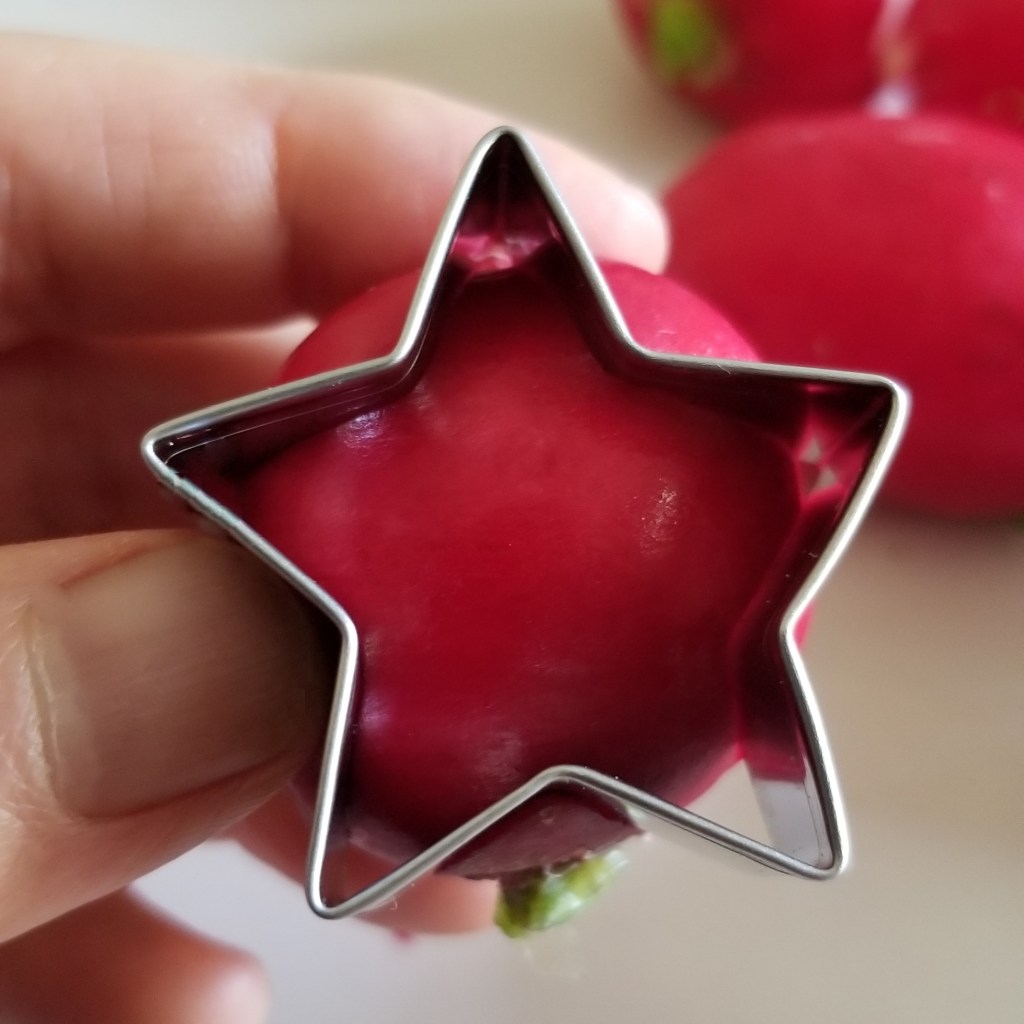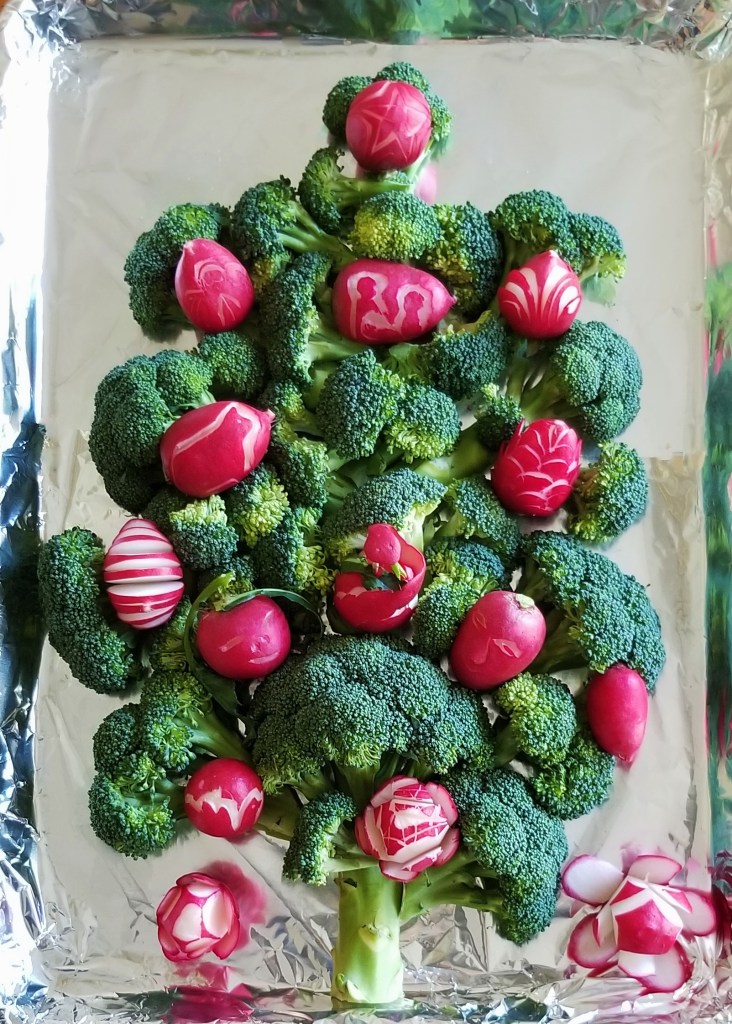
Continuing the Christmas theme in the Mexican state of Oaxaca from my previous posts (Buñuelos and Mole Negro), this post is about a truly unique craft from a festival known as “Noche de Rábanos” (Radish Night), celebrated on December 23 in the state’s capital city of Oaxaca. Radishes (Raphanus raphanistrum subsp. Sativus) are originally from Asia, but were known in Europe since ancient Roman times; they were one of the first crops introduced to the American continent, and specifically in Mexico, they became naturalized and cultivated in large scale, used for their juicy roots and also for their green tops, in stews, salads and as garnish. During colonial times, Dominican friars planted vegetable gardens for the community of Antequera, currently Oaxaca City; some historians have mentioned garden contests even back then, in which the radishes were sometimes carved, especially with religious themes. There is a legend that one year, the radish crop was so abundant, that many roots remained unharvested, becoming oversized, leathery and deformed in the soil; friars pulled up some of these forgotten radishes in December, and found them so curious that brought them to the Christmas vigil market, already held on December 23 in preparation for the Christmas celebrations. The large and twisted roots attracted great attention and the friars encouraged the farmers to carve them as a visual aid, to increase their sales. People began buying the radishes not only to eat, but to create centrepieces for their own Christmas dinners, and even just attended the market to admire the creativity of the vendors.
In 1897, mayor Francisco Vasconcelos Flores, created a formal radish carving competition, which has been held each year since then. Nowadays, radish crops are cultivated specifically for Radish Night near the city’s airport, with the harvest taking place around December 18, to give the competitors a few days to create their master pieces. In addition to the displays of radishes, artisans compete in other categories, such as Flor inmortal – Inmortal Flower, using dried flowers, and Totomoxtle – the Nahuatl name for corn husks, used in their many natural colours, from cream to purple, as well as decorated. To see some of the beautiful creations from past Noches de rábanos, visit for example, a post at View from Casita Colibrí. December 23 in Oaxaca City has almost become a holiday on its own, with a mix of produce and glittery decorations at the market, traditional Mexican jingles and dances afterwards, and people a-wassailing with cheer; this year, however, due to the COVID19 pandemic, although the radish harvest has taken place as scheduled, the 2020 competitions and celebrations will take place all in digital/remote formats.
Inspired by this festival, I decided to create my own radish art; the only red radishes available around here this time of year are the round and small Cherry Bell; I bought two bunches at the supermarket, as well as two broccoli heads. I washed and dried all the produce, then prepared a background of broccoli florets, first slicing the largest ones in half lengthwise, to create flat surfaces, and arranging them in the shape of a tree, in a large tray:

Then, I filled in the shape with smaller florets, for a full-looking green tree:

To carve the radishes, I started with easy straight cuts with a paring knife, to create simple pinecones and flowers (photo below, left). I also used a metal mini cutter, to stamp a star for the top of my tree (photo below, right):


For more ambitious designs, such as the Nativity scene at the top of this post, I used another mini cutter for the cow’s silhouette, and the tip of the paring knife to carve the baby in the manger (photo below, left), and the angel on the left. Finer details, such as eyes, were done with a toothpick (photo below, right):


Another religious motif was “The Garden of Eden”, near the bottom of my tree:

I carved a few more flowers, animals and abstract ornaments, and arranged them all on the broccoli tree, for the final look:

The shape of my tree was purposely not a pine tree. I thought the effect was nice, like a hybrid between a Christmas tree with red ornaments, and an iconic Mexican “Arbol de la vida” – Tree of Life:

These crafts are traditionally made with local clays from Central Mexico; the depiction of a “tree of life” in this form, as well as in paintings and other mediums, was first introduced in Mexico by the Spaniards as a way to illustrate Biblical stories to the native population, particularly “The Creation” and “The Garden of Eden.” Local artisans in the states of Puebla and Edo. de México, especially in Metepec (one of Mexico’s “Pueblos Mágicos”), continue to depict these themes, and the art has evolved to include elements from nature and fantasy, such as birds, flowers, mermaids and unicorns, amongst many other motifs.
My radish and broccoli piece will adorn my dinner table on Christmas Eve, along with a couple of dips to have with the veggies as an appetizer. My avocado dressing and mayonnaise with chopped chipotle peppers are flavourful choices, with festive colours for this season:

FUN FACT – Totomoxtle as a novel material – Due to the globalization of maize (corn) as a crop for industrial applications (sweeteners, fuel, animal feed, etc.), many farming regions in Mexico have suffered extreme competition, and degradation of their soil caused by mono-culture of hybrid corn varieties. Tonahuixtla, a small town located in the Mexican state of Puebla, was affected by this trend; their land was in poor condition, and the town had been forced to stop producing many of their heirloom maize varieties. Mexican graphic designer Fernando Laposse has been working with a group of local families since 2016, and in conjunction with The International Maize and Wheat Improvement Center (Centro Internacional de Mejoramiento de Maíz y Trigo, or CIMMT) – with the world’s largest corn seed bank – native seeds have been slowly reintroduced in the village, returning to traditional agriculture practices, as well. Laposse developed the project ultimately to transform the dry husks collected from the harvest into a novel veneering material, creating even more of the much-needed local employment, particularly for women. The material was named Totomoxtle, from the Nahuatl word for corn husk, and it is the result of turning the dry husks of the native maize grown in Tonahuixtla, found in a variety of colours, into a beautiful and sustainable veneer material for furniture, walls and decorative pieces. For the full story, and to see many amazing examples of this material, visit the creator’s website.
ANOTHER FUN FACT: A Mexican ceramic “Tree of Life” from Metepec, appears as one of the props on the cover of The Beatles’ album “Sgt. Pepper’s Lonely Hearts Club Band”, instead of the image of Germán Valdés, a Mexican comedian, very popular back then; he had been asked to be a part of the famous cover, but he requested the “Arbol de la vida” to be included in his place.
I am linking to Cee’s Flower of the Day (FOTD) Challenge for December 23, 2020.








I love this creative way to celebrate fresh vegetables during the holiday season. What a great idea and from wonderful history too.
LikeLiked by 2 people
Thank you, Mason!
LikeLiked by 2 people
Amazing, Irene! Merry Christmas.
LikeLiked by 1 person
Thank you, Punam, big hug!
LikeLike
Creative presentation of vegetables, Irene! I love this healthy snack. Merry Christmas and happy holidays! 🙂
LikeLiked by 1 person
Thank you so much, Theresa, same to you!
LikeLiked by 2 people
Love your creativity! Alas, due to the virus, Noche de Rabanos is canceled this year — we are all missing it. And, thank you for the link. ¡Felices fiestas!
LikeLiked by 1 person
Very sad, but maybe I will try to catch some on Facebook; gracias y felicidades!
LikeLike
Thank you so much for introducing me to the Noche de rábano! That sounds like so much fun. I like the idea of Totomoxtle as well. Great natural source and beautiful colors.
LikeLiked by 1 person
Yes, these are examples of true eco- art, and have been around for years!
LikeLiked by 1 person
Over 120 years, so impressive! Mind if I borrow the topic for a post next week?
LikeLike
Not at all!
LikeLiked by 1 person
Awesome, such a fun topic. Feliz Navidad!
LikeLike
Feliz Navidad!
LikeLiked by 1 person
Looks too pretty to eat! Your carving skills are wonderful.
The corn husk veneers are really amazing!
LikeLiked by 1 person
Thank you, Eilene! I am fascinated by that material as well!
LikeLiked by 1 person
Somos un grupo de voluntarios y estamos abriendo un nuevo esquema en nuestra comunidad. Su sitio nos proporcionó información valiosa para trabajar. Has hecho un trabajo formidable y toda nuestra comunidad te lo agradecerá.
LikeLike